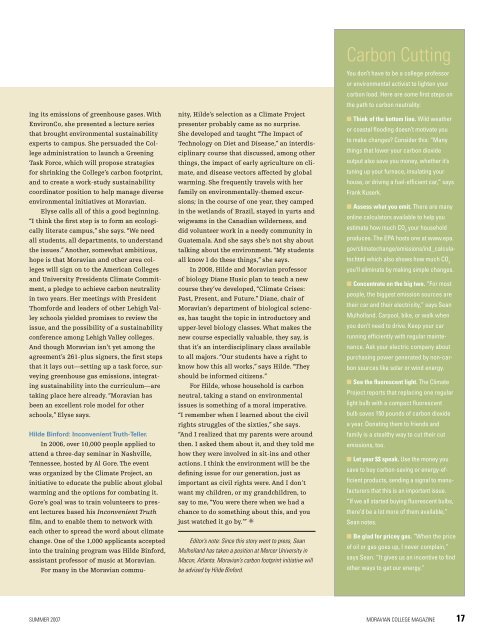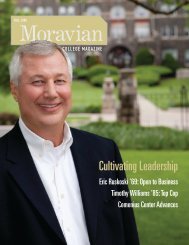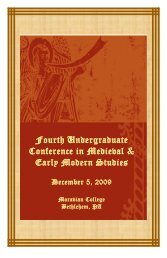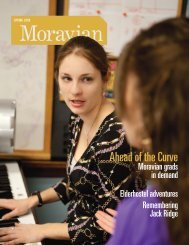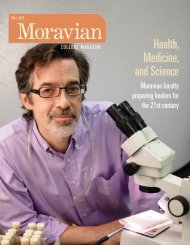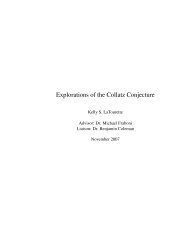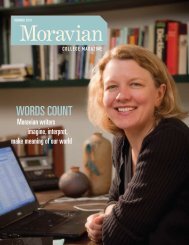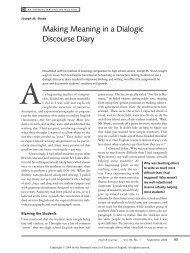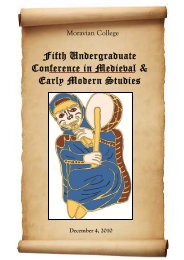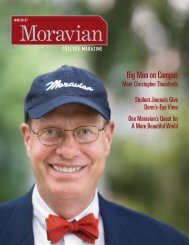Inauguration Weekend - Moravian College
Inauguration Weekend - Moravian College
Inauguration Weekend - Moravian College
Create successful ePaper yourself
Turn your PDF publications into a flip-book with our unique Google optimized e-Paper software.
ing its emissions of greenhouse gases. With<br />
EnvironCo, she presented a lecture series<br />
that brought environmental sustainability<br />
experts to campus. She persuaded the <strong>College</strong><br />
administration to launch a Greening<br />
Task Force, which will propose strategies<br />
for shrinking the <strong>College</strong>’s carbon footprint,<br />
and to create a work-study sustainability<br />
coordinator position to help manage diverse<br />
environmental initiatives at <strong>Moravian</strong>.<br />
Elyse calls all of this a good beginning.<br />
“I think the fi rst step is to form an ecologically<br />
literate campus,” she says. “We need<br />
all students, all departments, to understand<br />
the issues.” Another, somewhat ambitious,<br />
hope is that <strong>Moravian</strong> and other area colleges<br />
will sign on to the American <strong>College</strong>s<br />
and University Presidents Climate Commitment,<br />
a pledge to achieve carbon neutrality<br />
in two years. Her meetings with President<br />
Thomforde and leaders of other Lehigh Valley<br />
schools yielded promises to review the<br />
issue, and the possibility of a sustainability<br />
conference among Lehigh Valley colleges.<br />
And though <strong>Moravian</strong> isn’t yet among the<br />
agreement’s 261-plus signers, the fi rst steps<br />
that it lays out—setting up a task force, surveying<br />
greenhouse gas emissions, integrating<br />
sustainability into the curriculum—are<br />
taking place here already. “<strong>Moravian</strong> has<br />
been an excellent role model for other<br />
schools,” Elyse says.<br />
Hilde Binford: Inconvenient Truth-Teller.<br />
In 2006, over 10,000 people applied to<br />
attend a three-day seminar in Nashville,<br />
Tennessee, hosted by Al Gore. The event<br />
was organized by the Climate Project, an<br />
initiative to educate the public about global<br />
warming and the options for combating it.<br />
Gore’s goal was to train volunteers to present<br />
lectures based his Inconvenient Truth<br />
fi lm, and to enable them to network with<br />
each other to spread the word about climate<br />
change. One of the 1,000 applicants accepted<br />
into the training program was Hilde Binford,<br />
assistant professor of music at <strong>Moravian</strong>.<br />
For many in the <strong>Moravian</strong> commu-<br />
nity, Hilde’s selection as a Climate Project<br />
presenter probably came as no surprise.<br />
She developed and taught “The Impact of<br />
Technology on Diet and Disease,” an interdisciplinary<br />
course that discussed, among other<br />
things, the impact of early agriculture on climate,<br />
and disease vectors affected by global<br />
warming. She frequently travels with her<br />
family on environmentally-themed excursions;<br />
in the course of one year, they camped<br />
in the wetlands of Brazil, stayed in yurts and<br />
wigwams in the Canadian wilderness, and<br />
did volunteer work in a needy community in<br />
Guatemala. And she says she’s not shy about<br />
talking about the environment. “My students<br />
all know I do these things,” she says.<br />
In 2008, Hilde and <strong>Moravian</strong> professor<br />
of biology Diane Husic plan to teach a new<br />
course they’ve developed, “Climate Crises:<br />
Past, Present, and Future.” Diane, chair of<br />
<strong>Moravian</strong>’s department of biological sciences,<br />
has taught the topic in introductory and<br />
upper-level biology classes. What makes the<br />
new course especially valuable, they say, is<br />
that it’s an interdisciplinary class available<br />
to all majors. “Our students have a right to<br />
know how this all works,” says Hilde. “They<br />
should be informed citizens.”<br />
For Hilde, whose household is carbon<br />
neutral, taking a stand on environmental<br />
issues is something of a moral imperative.<br />
“I remember when I learned about the civil<br />
rights struggles of the sixties,” she says.<br />
“And I realized that my parents were around<br />
then. I asked them about it, and they told me<br />
how they were involved in sit-ins and other<br />
actions. I think the environment will be the<br />
defi ning issue for our generation, just as<br />
important as civil rights were. And I don't<br />
want my children, or my grandchildren, to<br />
say to me, “You were there when we had a<br />
chance to do something about this, and you<br />
just watched it go by.’” ✷<br />
Editor’s note: Since this story went to press, Sean<br />
Mulholland has taken a position at Mercer University in<br />
Macon, Atlanta. <strong>Moravian</strong>’s carbon footprint initiative will<br />
be advised by Hilde Binford.<br />
Carbon Cutting<br />
You don’t have to be a college professor<br />
or environmental activist to lighten your<br />
carbon load. Here are some fi rst steps on<br />
the path to carbon neutrality:<br />
■ Think of the bottom line. Wild weather<br />
or coastal fl ooding doesn’t motivate you<br />
to make changes? Consider this: “Many<br />
things that lower your carbon dioxide<br />
output also save you money, whether it’s<br />
tuning up your furnace, insulating your<br />
house, or driving a fuel-effi cient car,” says<br />
Frank Kuserk.<br />
■ Assess what you emit. There are many<br />
online calculators available to help you<br />
estimate how much CO your household<br />
2<br />
produces. The EPA hosts one at www.epa.<br />
gov/climatechange/emissions/ind_calculator.html<br />
which also shows how much CO2 you’ll eliminate by making simple changes.<br />
■ Concentrate on the big two. “For most<br />
people, the biggest emission sources are<br />
their car and their electricity,” says Sean<br />
Mulholland. Carpool, bike, or walk when<br />
you don’t need to drive. Keep your car<br />
running effi ciently with regular maintenance.<br />
Ask your electric company about<br />
purchasing power generated by non-carbon<br />
sources like solar or wind energy.<br />
■ See the fl uorescent light. The Climate<br />
Project reports that replacing one regular<br />
light bulb with a compact fl uorescent<br />
bulb saves 150 pounds of carbon dioxide<br />
a year. Donating them to friends and<br />
family is a stealthy way to cut their cut<br />
emissions, too.<br />
■ Let your $$ speak. Use the money you<br />
save to buy carbon-saving or energy-effi<br />
cient products, sending a signal to manufacturers<br />
that this is an important issue.<br />
“If we all started buying fl uorescent bulbs,<br />
there’d be a lot more of them available,”<br />
Sean notes.<br />
■ Be glad for pricey gas. “When the price<br />
of oil or gas goes up, I never complain,”<br />
says Sean. “It gives us an incentive to fi nd<br />
other ways to get our energy.”<br />
SUMMER 2007 MORAVIAN COLLEGE MAGAZINE 17


